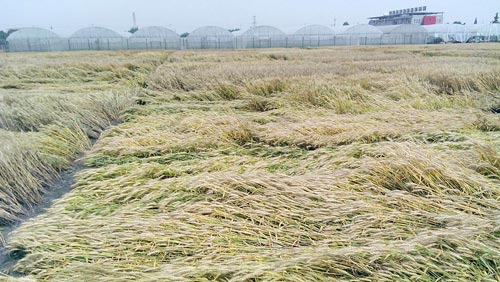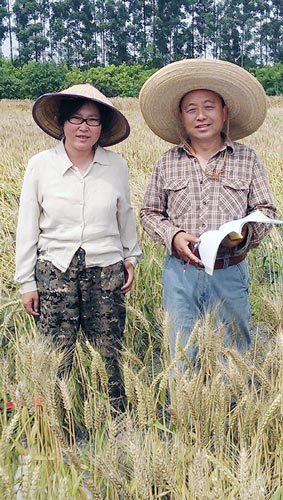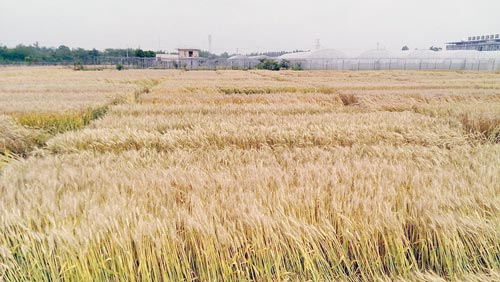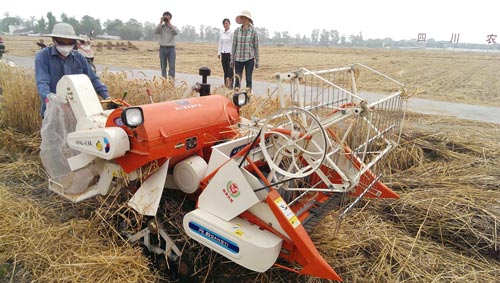By Garry Rosewarne/CIMMYT

The “boom-bust cycle” of resistance genes refers to the widespread use of a single resistance gene that protects multiple varieties of a grain from a disease (boom). When the disease overcomes this resistance gene many varieties simultaneously become susceptible (bust). The wheat cultivar Mianmai 37, released in 2004, has always had high levels of resistance to yellow rust. However, in the 2013-14 season in China’s Chengdu basin, this cultivar has high levels of the disease, indicating a new rust pathotype has likely evolved. CIMMYT researchers are awaiting investigations by pathologists to confirm the presence of a new race. Mianmai 37 has been extremely popular in western China and has been used as the high-yielding check in the government-run provincial yield trials for several years. It is also used extensively in breeding programs throughout the region, but with the outbreak of this new pathotype, several breeders have reportedly lost between 60 percent and 80 percent of their breeding stocks. About 60 percent of entries in the government trials have also showed susceptibility this year, despite testing last year that showed they were all highly resistant. It is unknown which resistance gene has been overcome.

This new virulence comes on top of the V26 pathotype that first appeared in 2011-12. This pathotype took out the widely used gene Yr24/26, rendering many varieties susceptible. Of major concern was the apparent loss of resistance in the CIMMYT derived cultivar Chuanmai 42, the world’s first commercially released variety with a synthetic background, which showed a 15 to 20 percent leap in yield potential compared with the best non-synthetic lines in the region. Fortunately, Chuanmai 42 was segregated for resistance to V26, and reselections were quickly made and seed was bulked up so that this high-yielding variety can still be grown. The new yellow rust pathotypes have had virtually no effect on the CIMMYT nurseries in the region, where the vast majority of lines are maintaining their durability.
CIMMYT is collaborating with the Sichuan Academy of Agricultural Sciences (SAAS) and the Chinese Government State Affairs for Foreign Expert Administration, which partially funds Dr. Garry Rosewarne’s work, on various projects to improve China’s wheat yields. Over the past three years, in conjunction with Dr. Yang Ennian, a breeding program has been established that focuses solely on the use of adult plant resistances. This program is also virtually unaffected by the arrival of new pathotypes. This year, fixed lines were selected from the most advanced material, and these will be grown on small observation plots next year. Not only is the use of slow-rusting genes having an effect in this program, but the change from pedigree breeding to selected bulk generation advancement is resulting in much more efficient field operations. This, combined with extensive use of summer nurseries, will see an increase in efficiency of up to 50 percent in the breeding program.

Dr. Zhu Huazhong of SAAS is also using slow-rusting genes from CIMMYT, albeit for a different reason. Chinese material is generally completely susceptible to the wheat stem rust lineages of Ug99. Although stem rust is rare in China, Dr. He Zhonghu recognized that it would be prudent to employ a pre-emptive breeding strategy in preparation for a potential incursion of Ug99. To this end, Dr. Zhu has been making crosses between Sichuan material and several of the CIMMYT stem rust nurseries in China. Not only are these lines showing good yellow rust resistance in yield trials, there appears to be an increase in lodging tolerance.

CIMMYT’s Sichuan office also is testing machine harvesting of yield trials using a Chinese-built small plot harvester that costs about US $6,000, with hopes of implementing multi-location yield trials so lines can be more rigorously tested for yield stability. Collaborative breeding and research activities throughout China are also being driven by the Sichuan office, where slow-rusting germplasm is being distributed to selected key breeding programs to use in their hybridizations. Genetic populations have also been distributed for multiple environment testing against yellow rust, leaf rust, powdery mildew and fusarium head blight. Other research is focusing on quantifying the value of slow-rusting genes under epidemic conditions, using molecular markers to pyramid slow-rusting genes behind major seedling resistances and identifying novel resistance genes to yellow rust.
Varietal uptake by farmers is particularly difficult in China, where new seed can cost up to US$ 1,000 per ton. In a novel venture for this region, a seed company is being paid by the provincial government to grow another CIMMYT synthetically derived cultivar, Chuanmai 104, and the seed will be given directly to farmers in an effort to improve yields in the region.
 Capacity development
Capacity development